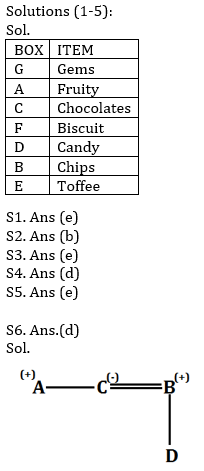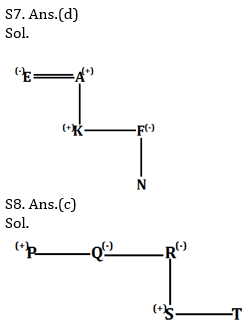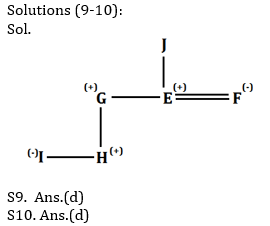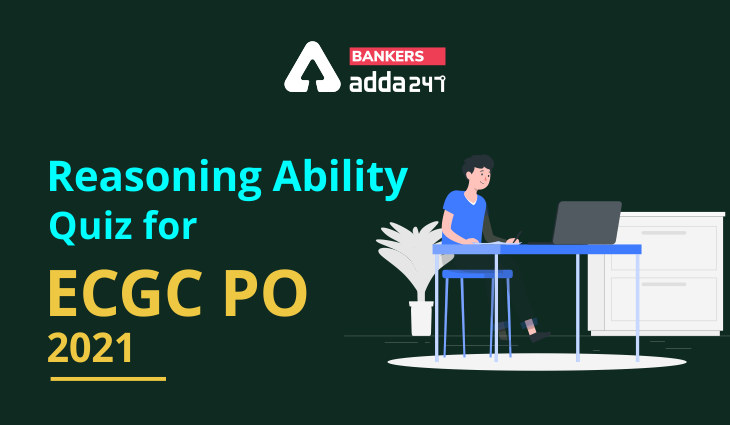Table of Contents
Directions (1-5): Study the following information carefully and answer the questions given below:
Seven boxes are arranged in a stack A, B, C, D, E, F and G are placed one above another (but not necessarily in the same order) are containing seven different items i.e. gems, biscuits, chips, chocolates, candy, toffees and fruity. Four boxes are between the box A and the one which contains toffees. Box B contains chips. Only one box is between F and A. Only three boxes are between A and B. F is placed in the middle of the stack. Same number of boxes are placed between F and G and F and the box which contains toffees.
G does not place below the box which contains Chips. Only one box is between the box which contains chocolates and box D. The box that contains gems is above the box that contains chocolates but not place immediate above the box that contains chocolates. Only one box is between the box which contains gems and box C. E contains toffees. F does not contain candy and fruity. D does not contain fruity. Box C is not placed below D.
Q1. How many boxes is/are there below G?
(a) One
(b) Two
(c) Three
(d) Four
(e) More than four
Q2. ‘box C’ contains which of the following item?
(a) Biscuit
(b) Chocolates
(c) Candy
(d) Fruity
(e) none of these
Q3. Find the pair of item and boxes which is correct?
(a) D- Chocolates
(b) C- Fruity
(c) B-Biscuit
(d) A- Candy
(e) None of the above is true.
Q4. Which of the following box is immediate below the box that contain biscuit?
(a) A
(b) B
(c) C
(d) D
(e) None of these
Q5. Which of the following item belongs to the box which is immediate above G?
(a) Biscuit
(b) Chocolates
(c) Candy
(d) Fruity
(e) none
Directions (6-8): Study the information carefully and answer the questions given below.
P + Q means P is Sister of Q
P – Q means P is brother of Q
P x Q means P is Wife of Q
P & Q means P is Mother of Q
P ÷ Q means P is of Father Q
Q6. In the expression A – C × B ÷ D, how is A related to D?
(a) Brother-in-law
(b) Sister-in-law
(c) Nephew
(d) Uncle
(e) Can’t be determined
Q7. In the expression E x A ÷ K − F & N, how is N related to E?
(a) Son
(b) Daughter
(c) Grandson
(d) Can’t be determined
(e) None of these
Q8. Which of the following expressions shows that R is mother of T?
(a) P + R – Q + T ÷ S
(b) P × R & Q ÷ T + S
(c) P − Q + R & S − T
(d) R + P × S ÷ Q − T
(e) None of these
Directions (9-10): Study the following information carefully and answer the given questions:
E, F, G, H, I and J are six family members. E and F are a married couple. I is sister of H. F is daughter-in-law of J, who is grandmother of I’s brother. H is the only son of G, who is brother of E.
Q9. What is the relation of F with H?
(a) Brother
(b)Mother
(c)Uncle
(d)Aunt
(e)None of these
Q10. How is G related to I?
(a)Mother
(b)Brother
(c)Sister
(d)Father
(e)None of these
Directions (11-15): Study the following information carefully and answer the given questions.
In number arrangement machine when given an input line of numbers, it rearranges them following a particular rule in each step. The following is an illustration of input and rearrangement.
Input: 53 22 64 37 18 95 46 73
Step I: 74 53 22 64 95 46 73 16
Step II: 36 74 64 95 46 73 16 20
Step III: 38 36 74 64 95 16 20 44
Step IV: 60 38 36 74 16 20 44 62
And step IV is the last step of the arrangement.
As per the above rule followed in the above steps, find out in each of the following questions the appropriate step for the input given below;
Input: 84 25 69 14 58 93 46 75
Q11. Which of the following is the last step of above input?
(a) III
(b) VI
(c) IV
(d) V
(e) None of these
Q12. Which is the following step?
Step: 58 97 53 84 93 12 44 56
(a) VI
(b) III
(c) IV
(d) V
(e) There is no such step
Q13. What is the sum of the digits of the 4th element from right end in Step II?
(a) 18
(b) 12
(c) 10
(d) 15
(e) 11
Q14. Which of the following elements lies exactly between 58 and 44 in step IV?
(a) 40
(b) 97
(c) 53
(d) 12
(e) None of these
Q15. What is the difference between the number which is 4th from the left in step II and the number which is 3rd from the right end in step IV?
(a) 20
(b) 18
(c) 13
(d) 14
(e) None of these
Practice More Questions of Reasoning for Competitive Exams:
Reasoning for Competitive Exams |
Reasoning Ability Quiz For ECGC PO 2021- 20th January |
Reasoning Ability Quiz For ECGC PO 2021- 19th January |
ECGC PO Study Plan 2021 |
Solutions



Solutions (11-15):
Sol.
In this input output question two numbers are arranged in each step following a certain pattern. Let us understand the logic behind it-
* Even numbers are arranged at the right end, from left to right in ascending order after subtracting 2 in each number.
* Odd numbers are arranged at the left end, from right to left in ascending order after the digits are interchanged within the number, then add 1 in each number.
Input: 84 25 69 14 58 93 46 75
Step I: 53 84 69 58 93 46 75 12
Step II: 97 53 84 58 93 75 12 44
Step III: 58 97 53 84 93 12 44 56
Step IV: 40 58 97 53 12 44 56 82
S11. Ans.(c)
S12. Ans.(b)
S13. Ans.(b)
S14. Ans.(c)
S15. Ans.(d)
Practice with Crash Course and Online Test Series for ECGC PO 2021:
- ECGC Online Coaching Classes for Probationary Officier 2021
- ECGC PO Mock Tests 2021 – Banking Online Test Series (With Solutions) by Adda247
- ECGC PO 2021 Complete eBooks Kit (English Medium)
Click Here to Register for Bank Exams 2020 Preparation Material




 GA Capsule for SBI Clerk Mains 2025, Dow...
GA Capsule for SBI Clerk Mains 2025, Dow...
 The Hindu Review October 2022: Download ...
The Hindu Review October 2022: Download ...
 ECGC PO Scorecard 2025 Out, Check Marks
ECGC PO Scorecard 2025 Out, Check Marks




